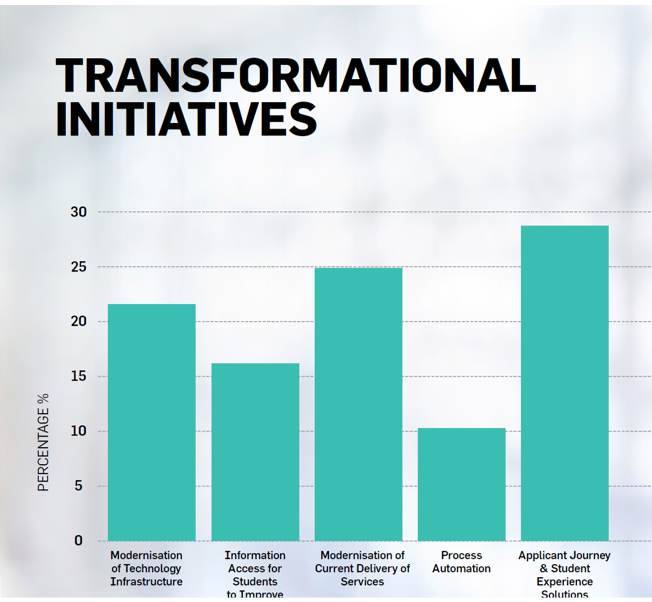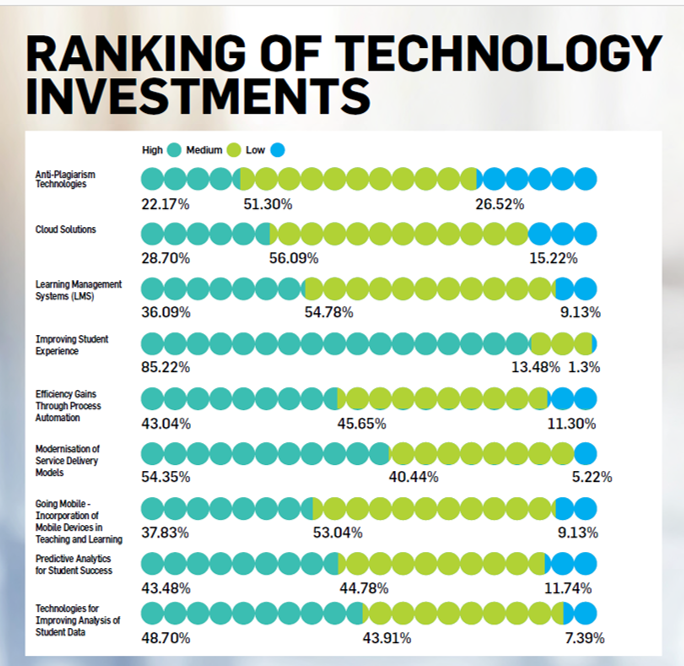The next steps to improve higher education technology
The Education Strategy Forum is an invitation-only meeting which brings together leaders within the higher education industry, alongside government representatives, policy makers and solutions providers – such as Crimson. The event was held on the 25th and 26th February, where they discussed the research report they produced, which is based on information obtained from delegates. The delegates are made up of 241 individuals from UK higher education institutions, including 17 Vice-Chancellors and C-Suite, 95 Directors, 84 Heads of Department and 45 members of Senior Management. They were interviewed over the phone and face-to-face, when they discussed trends and issues that are currently being tackled by university leaders. The report discusses the main findings of the research – student experience and engagement, data analytics, transformed learning, and the student journey – as well as discussing spending power, initiatives and investments.
Data Analytics
Data analytics were found to be a significant area that higher education institutions should improve. It can help to position students towards long-term success by examining demographic data, both current and historical. Data analysis highlights area which require improvement, which then results in advancements in student performance. This finding helps to make secure decisions that are based on evidence, and improves student well-being, engagement and the student journey.
Transformed Learning
Transformed learning was another finding from the Education Strategy Forum research report, as e-learning innovations, active learning classrooms and greater collaboration are becoming more and more popular. The move from traditional classroom-based learning offers more opportunities to both students and staff, therefore reaching a larger student audience.
Student Journey
Another key issue that was discussed in the Education Strategy Forum report was the student journey, where it was argued that improving the visibility of the student journey will improve success and graduate employability. A research report that Crimson produced discusses how drop-out rates are increasing – the drop-out rate for state schools at 6.5% and private-schools at 3.4% - whilst the number of applications is reducing. The student journey helps prospective students to create a clear vision of their education, which makes them more likely to continue their education with the institution. This is because they have support and guidance, and it enables any communication to be tailored specifically towards them – creating a stronger relationship.
Student Experience and Engagement
Student experience and engagement was a key finding discussed in the report, and it was also highlighted in the report produced by Crimson. The Education Strategy Forum report highlights the drive for a smart campus, leveraging innovative technology and omnichannel engagement, and notes how these will all enhance engagement and experience for both staff and students, as well as improving retention. New technologies can make education institutions stand out from the rest, for example by showing the various learning methods used by different students – from the mature student studying between family and work, to the late-night partier struggling to make it to their early morning lectures.
As the higher education market is so competitive, education institutions need to show potential students why they should choose to study with them. As well as the competitive market, the current price of education is high – university courses start at £9000 – so the choice of course and institution is something that cannot be taken lightly. Education is a significant investment and with a variety of options to choose from, institutions need to put a lot of effort into attracting and persuading people to study with them. Often, the big factors that affect university or college choice cannot be changed – location, notable alumni, local nightlife, campus, etc. So, what can higher education institutions change to attract and retain students? In the past, universities have made an effort to create renowned student societies, events and activities, but as we’re in the fourth industrial revolution, it is time to get technical.
How to transform higher education
The chart below, taken from the research report, demonstrates the ways in which education institutions can streamline their processes and continue to innovate. Applicant journey and student experience solutions were found to be the most transformational, with ‘modernisation of current delivery services’ and ‘modernisation of technology infrastructure’ scoring the next highest percentages. With all of these initiatives working together, they can all help to improve student engagement and experience, as well as the student journey.

Where are higher education institutions currently investing their money?
Across all technological investments, student experience is once again a priority for many institutions. The Education Strategy Forum research report shows how improving student experience is the highest priority, with modernising service delivery also highlighted as a key issue. The image below shows the investments made by the institutions – but it doesn’t explain exactly which methods and technologies are used during the investment process. This is where we come in.

What can be done to attract and retain students, solidifying the student journey?
The answer is a fully integrated CRM system that facilitates, tracks, records and organises all communications and insights, which enables a stronger and more personal relationship with prospective students, current students, alumni and staff. This provides a more accurate picture of information surrounding each individual, better service and support for current students, and produces data that is easier to collate and analyse. This centralised view of data that enables intelligent communications and support can decrease drop-out rates by 1% year-on-year.


